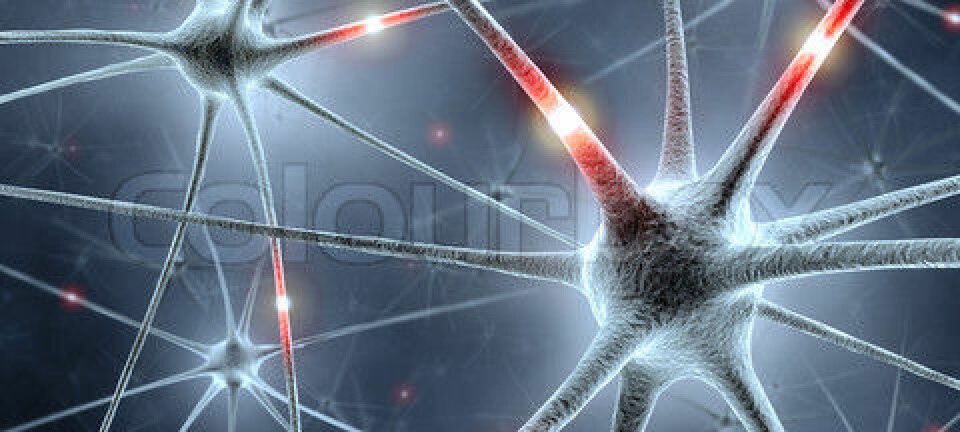An article from University of Oslo
The brain`s forgotten cells
For a long time, researchers have neglected the 100 million glial cells found in our brains, but that is no longer the case. Now they have discovered that the glial cells cleanse the brain of waste.
Denne artikkelen er over ti år gammel og kan inneholde utdatert informasjon.
New laser technology has enabled us to take a deeper look into the mysteries of the brain, showing that the glial cells are extremely important for its proper function.
In the long term, better knowledge about these cells can help improve the treatment of a number of brain diseases, such as epilepsy, migraine, stroke and dementia.
The glial cells lie between the nerve cells and encircle the blood vessels. There are at least as many glial cells as there are nerve cells in the brain.
Because researchers didn’t have the technology to discover their activity, the glial cells were previously regarded as passive support cells. “
Now we know that the glial cells can communicate with each other and with other brain cells. They just use another language than the nerve cells, which communicate by electrical impulses,” says Erlend A. Nagelhus, professor at the Institute of Basic Medical Sciences, University of Oslo.
The glial cells, on the other hand, use calcium ions and probably play a far more active role in the brain than was previously assumed
The brain’s washing machine
Nagelhus is head of the Letten Centre and GliaLab, whose objective is to identify the functions of the glial cells, especially the astrocytes – the star-shaped brain cells.
One reason why the astrocytes are so crucial is that the water channels are located within these cells.
These water channels are tiny pores in the astrocytes’ cell membrane. The pores are so narrow that only water molecules can pass through them.
Many years ago, researchers discovered that there are a particularly high number of water channels along the brain’s surface and around the blood vessels. The function of the water channels long remained a mystery. Now they know a little more.
“In contrast to other organs in the body, the brain has no lymphatic vessels. Therefore, we have been unable to understand how it disposes of waste material and excess tissue fluids,” says Nagelhus.
“In collaboration with researchers in the US we have now shown that the water channels in the glial cells are important for cleansing the brain.”
The water channels function like a washing machine and help rinse out waste material. At the same time, the water channels may exacerbate other damage, for example in the case of a stroke or a head injury.
In conditions like these they can transport too much water into the brain, causing a life-threatening increase in pressure.
If a sudden brain injury occurs, it will normally be advantageous to stop the flow of water through the channels. Efforts are therefore underway to develop drugs that can block the water channels.
A window to the mysteries of the brain
Many of the projects undertaken by the Nagelhus group seek to find out what happens to the brain’s signalling system as we grow older and when the brain is affected by disease.
To see what happens inside the brain, both how the cells communicate with each other and how the brain rids itself of waste products, the researchers use highly sophisticated laser microscopy.
By drilling a hole in the cranium of anaesthetized mice and mounting a small glass pane over the hole, they obtain a kind of window to the mysteries of the brain.
Nagelhus and his colleagues then inject fluorescent dyes into the brain, and the laser beams make the cells and matter in the cerebral fluid light up while they take photos.
This sophisticated laser technique has enabled the researchers to show that the astrocytes are not silent, and that brain cells can communicate in other ways than by electrical impulses.
“The astrocytes are extremely active, and they also react to the electrical impulses emitted by the nerve cells. A new fluorescent substance that we inject into the mice’s brains lights up when the calcium level in the astrocytes increases,” says Nagelhus.
This substance permits the researchers to see when the astrocytes communicate with each other and with other brain cells.
“We seek to understand the interplay between nerve cells, astrocytes and blood vessels. This may help us understand what goes wrong in many different brain disorders,” says Nagelhus.
Simulation of a migraine attack
Some researchers believe that the glial cells are also important for our memory.
“We wish to find out more about this. We are in the process of establishing methods for brain imaging on awake laboratory mice,” says Nagelhus.
Here the mice can be trained to run on a treadmill or a polystyrene ball while under the microscope. At the same time, they can be trained to perform simple tasks.
“Such trials can provide us with knowledge about the importance of glial cells for learning, memory and behaviour,” says the researcher.


































